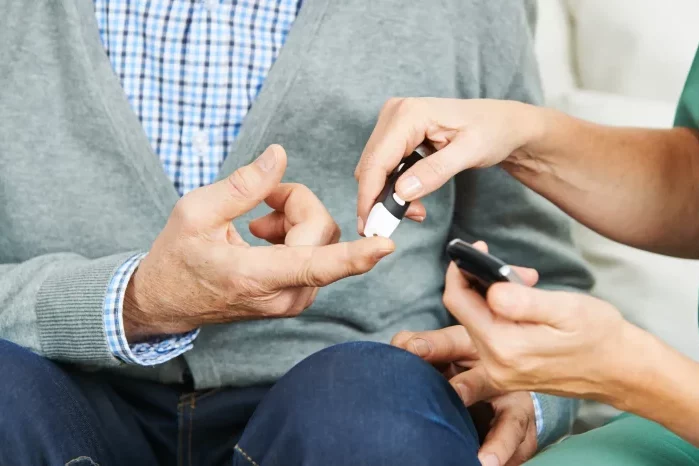Diabetes mellitus, a chronic condition characterized by elevated blood glucose levels, affects millions worldwide. Effective management of diabetes requires regular monitoring of blood glucose levels, traditionally accomplished through finger-prick tests. However, the discomfort and inconvenience associated with these invasive methods have spurred significant advancements in non-invasive blood glucose monitoring technologies. This article explores various non-invasive methods available for blood glucose measurement, their mechanisms, advantages, and current status in the market.
The Need for Non-Invasive Blood Glucose Monitoring
Challenges with Traditional Methods
Traditional blood glucose monitoring involves pricking the finger to obtain a blood sample, which is then analyzed using a glucometer. Despite its accuracy, this method presents several challenges:
- Pain and Discomfort: Repeated finger pricks can cause pain and discomfort, discouraging regular monitoring.
- Risk of Infection: Poor hygiene during pricking can lead to infections.
- Inconvenience: Carrying lancets, test strips, and glucometers can be cumbersome, particularly for individuals with active lifestyles.
- Psychological Barriers: Anxiety related to needles and blood can deter some individuals from consistent monitoring.
Given these drawbacks, the development of non-invasive glucose monitoring technologies is highly desirable. Such advancements promise to enhance patient compliance, improve quality of life, and lead to better diabetes management.
Non-Invasive Blood Glucose Monitoring Technologies
Continuous Glucose Monitoring (CGM) Systems
Mechanism: Continuous Glucose Monitoring (CGM) systems use a small sensor inserted under the skin to measure interstitial glucose levels. The sensor transmits data to a wearable device, which displays glucose readings continuously.
Advantages:
- Real-Time Data: Provides continuous glucose readings, allowing for timely interventions.
- Trend Analysis: Enables analysis of glucose trends over time, aiding in better diabetes management.
- Alerts: Many CGM systems offer alarms for hypo- and hyperglycemic events.
Challenges:
- Semi-Invasive: Although less invasive than finger-pricking, CGMs still require sensor insertion.
- Cost: CGM systems can be expensive, with recurring costs for sensors.
- Calibration: Some CGM systems require periodic calibration with finger-prick tests.
Flash Glucose Monitoring (FGM)
Mechanism: Flash Glucose Monitoring (FGM) systems, such as the FreeStyle Libre, involve wearing a sensor on the skin. Users scan the sensor with a reader or smartphone to obtain glucose readings.
Advantages:
- Convenience: Scanning is painless and quick, providing an alternative to finger-pricking.
- Trends and Patterns: Offers insights into glucose trends and patterns.
- Reduced Finger-Pricks: Less frequent need for finger-prick calibration compared to CGMs.
Challenges:
- Intermittent Data: Unlike CGMs, FGMs provide data only when scanned, lacking real-time continuous monitoring.
- Sensor Replacement: Sensors need to be replaced every 10-14 days, incurring ongoing costs.
- Accuracy: May not be as accurate as traditional blood glucose meters, particularly during rapid glucose changes.
Optical Methods
Mechanism: Optical methods involve using light to measure glucose levels. Techniques such as near-infrared spectroscopy (NIR), Raman spectroscopy, and photoacoustic spectroscopy are explored for their potential in non-invasive glucose monitoring.
Advantages:
- Non-Invasive: Completely avoids the need for needles and blood samples.
- Convenience: Devices can be integrated into everyday items like watches or phones.
Challenges:
- Accuracy: Variability in skin properties and external factors like temperature can affect accuracy.
- Complexity: Requires sophisticated technology and algorithms to interpret optical signals accurately.
- Development Stage: Many optical methods are still in experimental or early commercial stages.
Transdermal Methods
Mechanism: Transdermal methods involve extracting glucose through the skin using techniques like reverse iontophoresis or sonophoresis. Devices such as the GlucoWatch use reverse iontophoresis to measure glucose levels.
Advantages:
- Non-Invasive: Eliminates the need for blood samples.
- Continuous Monitoring: Can provide continuous glucose readings.
Challenges:
- Skin Irritation: Prolonged use can cause skin irritation or allergic reactions.
- Calibration: Requires calibration with traditional finger-prick tests.
- Accuracy: Environmental factors can influence measurement accuracy.
Breath Analysis
Mechanism: Breath analysis measures volatile organic compounds (VOCs) like acetone in the breath, which correlates with blood glucose levels. Technologies like breathalyzers for glucose are under development.
Advantages:
- Non-Invasive: Simple and painless to use.
- Ease of Use: Can be used like a traditional breathalyzer.
Challenges:
- Correlation: The correlation between breath acetone and blood glucose can be influenced by diet and metabolism.
- Development Stage: Currently in research and development, with limited commercial availability.
Saliva and Tear Fluid Analysis
Mechanism: Analyzing glucose levels in saliva or tear fluid offers a non-invasive alternative. Devices like smart contact lenses and saliva sensors are being researched.
Advantages:
- Non-Invasive: Uses easily accessible biological fluids.
- Convenience: Potential for integration into everyday items like contact lenses.
Challenges:
- Low Glucose Concentration: Glucose levels in saliva and tears are significantly lower than in blood, posing detection challenges.
- Development Stage: Most technologies are still in experimental stages.
Electromagnetic Methods
Mechanism: Electromagnetic methods use radio waves or microwaves to detect glucose levels. Devices like the GlucoTrack use electromagnetic waves to measure glucose non-invasively.
Advantages:
- Non-Invasive: No need for blood samples.
- Continuous Monitoring: Potential for continuous or frequent monitoring.
Challenges:
- Accuracy: Variability in tissue properties can affect measurement accuracy.
- Complexity: Requires advanced technology and algorithms.
Current Market Landscape and Future Prospects
Available Products
Several non-invasive or minimally invasive glucose monitoring products are currently available or in development:
- FreeStyle Libre: A widely used FGM system that provides glucose readings upon scanning the sensor.
- Dexcom G6: A popular CGM system known for its accuracy and real-time data.
- Eversense: An implantable CGM system offering long-term monitoring.
Research and Development
Significant research efforts are underway to improve non-invasive glucose monitoring technologies. Key areas of focus include:
- Improving Accuracy: Enhancing the precision of non-invasive methods to match traditional blood glucose meters.
- User Experience: Developing user-friendly devices that integrate seamlessly into daily life.
- Cost Reduction: Making technologies more affordable and accessible to a broader population.
- Regulatory Approval: Securing approval from regulatory bodies like the FDA and CE for new devices.
Challenges and Opportunities
Regulatory Hurdles: Non-invasive devices must meet stringent regulatory standards to ensure safety and accuracy. This process can be lengthy and costly, delaying market entry.
Consumer Acceptance: User acceptance is crucial for the success of non-invasive monitoring devices. Factors such as ease of use, comfort, and perceived accuracy influence consumer adoption.
Technological Advancements: Continued innovation in sensor technology, data algorithms, and materials science holds promise for the future of non-invasive glucose monitoring.
Market Competition: As more players enter the market, competition can drive innovation and reduce costs, benefiting consumers.
The Future of Diabetes Management
The development of non-invasive blood glucose monitoring technologies represents a significant leap forward in diabetes management. These advancements have the potential to:
- Enhance Compliance: By reducing the discomfort and inconvenience associated with traditional methods, non-invasive devices can encourage more consistent glucose monitoring.
- Improve Outcomes: Continuous and accurate glucose monitoring allows for timely interventions, reducing the risk of complications associated with diabetes.
- Empower Patients: Providing patients with easy-to-use, non-invasive tools empowers them to take control of their health and make informed decisions.
Conclusion
Non-invasive blood glucose monitoring technologies are revolutionizing diabetes care. While challenges remain, ongoing research and technological advancements are paving the way for more accurate, convenient, and user-friendly devices. As these technologies continue to evolve, they hold the promise of transforming the lives of individuals with diabetes, making glucose monitoring a seamless part of daily life and improving overall health outcomes.
Related topics:
Can not eating all day cause low blood sugar?

























